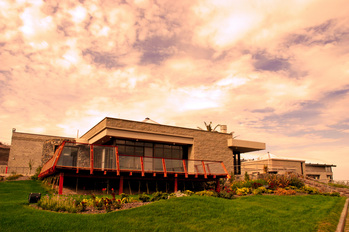Patagonia and Pinot Noir - “Condemned To Quality”
Patagonia is Argentina's southernmost wine-growing region. Its Pinot Noirs have gained in popularity the past six years, since most of the Patagonic vineyard plantings around 2000. The three wine-growing areas of Patagonia are Neuquen and Rio Negro along with Chubut. Rio Negro is the only area in the region that's been planted for over 90 years.
The Landscape And Terroir
Patagonia is known as cold and windy with starkly beautiful landscapes. It was recently designated as the No. 2 most wished for travel-adventure destination. There's one inhabitant per square meter in a country whose population is 40 million.
To travel from Mendoza, Argentina's main wine-growing region, to Neuquen, in Patagonia, you will cover 800km. The crop yield from the two areas is just as contrasting: Mendoza averages 60 tons per acre, whereas Rio Negro yields approximately 20-25 tons per acre. Hence the phrase, “We are condemned to quality,” explained Federico Boxaca of Familia Schroeder, the Patagonia winery that makes the 100% Pinot Noir vintage, Saurus Patagonia Select Pinot Noir.
North Patagonia's growing conditions are ideal for Pinot Noir. This delicate, old and noble variety requires an arid climate, short summer and cold winter. The Pinot Noir grown in Patagonia has smooth tannins, a deep ruby color and aromatics of black fruit.Argentina's Late-comer
The logistics of Patagonia is what makes it a regional late-comer to the game of grape growing. “It's long been perceived as too expensive and too unpredictable,” explained Boxaca. In fact, when Chandon started his winery in Argentina in the 60's, they first looked at Patagonia. They found that it gave great acidity, at the levels necessary for sparkling wines. However, since the train tracks were long laid by the English and span from Buenos Aires to Mendoza, easy access to Patagonia has been a long time coming.
Boxaca illuminates the region's good qualities even further: “We have soft, well-developed tannins; good acidity and low PH.” This is achieved through good vineyard management, one that has been developed to counter the ravaging of the region's wind factor.
The wineries of Patagonia have adapted their viticulture technology to the terroir characteristics so as to allow for high-quality wine – in this case Pinot Noir – production. Boxaca explained that growing a healthy vineyard of Patagonia Pinot Noir requires these three main things:
- A wind shield of planted Poplar trees around the vineyards to protect the vines from being overly stressed;
- The night to day temperature drop of about 20 degrees c. which amounts to good acidity, and
- The extra hour of sunlight which works for the harvest in this case. The chalky, Patagonia soil, formed by glaciation, houses deep round pebbles, something the Pinot Noir vine has taken a liking to.
It is said that in Argentina there are three things to drink: Water, water with wine, and wine. It is also said that a newborn baby, to stop it from crying, is offered a finger dipped in wine to pacify it. In a country where 40% of the population is descended from Italian and 30% from Spanish, it is no wonder that wine is so much in the blood.
The important thing here to consider, is Does the Patagonia Pinot Noir have that “drinkability factor?” That is, when you take a sip does your mouth water, is it appetizing, does it make you want to drink more? The answer is a resounding Yes. “There is much more to the Argentine story than Malbec,” commented Gismondi who toured Argentina's wine regions and came away with a solid sense of the country's wines. “The food is fantastic and in Argentina wine tasting is an adventure.”
In Patagonia there are currently a total of no more than seven wineries, including Familia Schroeder, Bodega del Fin del Mundo and Humberte Canale. Over 50% of the wineries have lodges and restaurants, noted Boxaca. Patagonia's “stunning landscapes” feature steppes, forests, glaciers and lakes.
Familia Schroeder's Saurus Patagonia Select Pinot Noir '06 is made with 100% Pinot Noir grapes, aged 12 months in 70% French, 30% American oak and is now showing well and full-bodied. Find notes of Cherries, berries.
Familia Schroder's Icon Wine features a simple metallic label and is a heavy, thick-glass bottle. They've only made 1,000 cases for the world. It's a blend of 54% Pinot Noir, 46% Malbec and in '08 their '04 vintage took gold in Le Mondial du Vin competition in Switzerland. Velvety on the mouth, ripe-red, dark berries.
“Soft tannins is what we have in Argentina,”commented Daniel Pi who is the head professor at the Oenological Department at the University of Mendoza in Argentina. “We can ripen the grapes until the time when we pick them. We don't have to pick the grapes early. We are far from the ocean and its cooling breezes. We don't have the pressure to pick the grapes because they are cold.” Wine Harvest, with its attendant pagan expressions and spectacular moments, is in March.
Evocative of Argentina is the image of a mounted horseman, a gaucho, riding across a swath of rural land. The iconic gaucho has long been associated with Argentina and its culture. Its imagery evokes association with freedom, silence, honesty, strength, laziness, melancholy and horsemanship. Since 2001, and despite high inflation, Argentina enjoys economic growth and social stability.







Patagonia adventure options are as varied as the terrain. You can secure crampons and trek a glacier, board a motor yacht and explore the fjords, or grab your packs and head for the towering spires of Chile's Torres del Paine. I loved it when I was there. I had rented one of those buenos aires apartments first and spent a period of 3 weeks in the big city, going to the must see places. Then I headed to Patagonia and I saw the most amazing things.
ReplyDeletePlease if somebody hasn´t gone yet, do so, nobody will regret it!
Brit